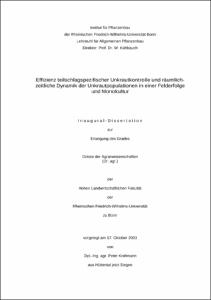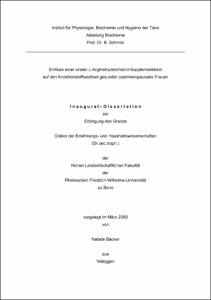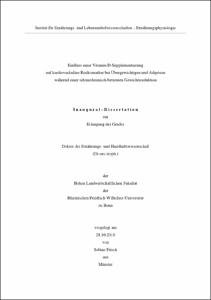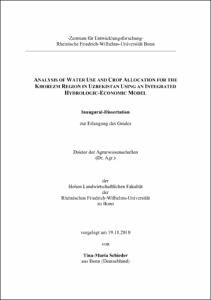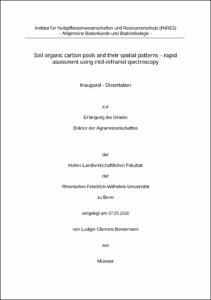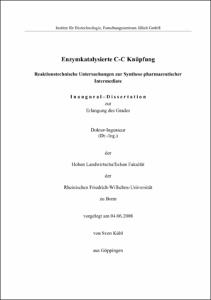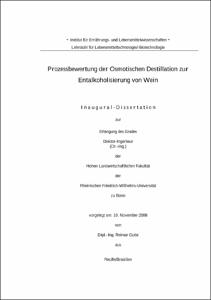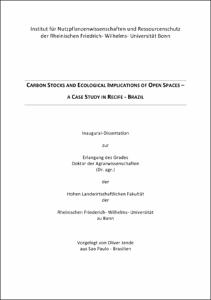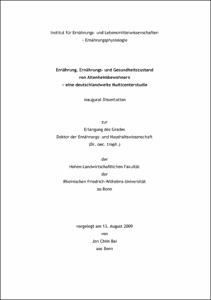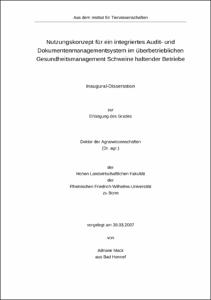E-Dissertationen: Suche
Anzeige der Dokumente 1-10 von 63
Effizienz teilschlagspezifischer Unkrautkontrolle und räumlich-zeitliche Dynamik der Unkrautpopulationen in einer Felderfolge und Monokultur
(2004)
Im Rahmen der vorliegenden Studie wurden Untersuchungen zur Dynamik von Unkrautpopulationen unter dem Einfluss der teilschlagspezifischen Unkrautkontrolle in einer viergliedrigen Felderfolge Körnermais-Zuckerrüben-Winter ...
Einfluss einer oralen L-Argininhydrochlorid-Supplementation auf den Knochenstoffwechsel gesunder postmenopausaler Frauen
(2003)
Einleitung: Aktuelle Forschungsergebnisse zeigen eine positive Wirkung des freien Radikals Stickstoffmonoxid (NO) auf den Knochenstoffwechsel. Erste Humanexperimente bestätigen einen positiven Einfluss einer ...
Einfluss einer Vitamin D-Supplementierung auf kardiovaskuläre Risikomarker bei Übergewichtigen und Adipösen während einer telemedizinisch betreuten Gewichtsreduktion
(2011-07-04)
Die Prävalenz einer Hypovitaminose D bei übergewichtigen und adipösen Personen ist hoch. Niedrige Blutkonzentrationen an den Vitamin D-Metaboliten 25-Hydroxyvitamin D (25(OH)D) und Calcitriol (1,25(OH)2D) sowie hohe ...
Analysis of Water Use and Crop Allocation for the Khorezm Region in Uzbekistan Using an Integrated Hydrologic-Economic Model
(2011-04-20)
Sustainable and efficient water management is of central importance for the dominant agricultural sector and thus for the population and the environment of the Khorezm region. Khorezm is situated in the lower Amu Darya ...
Soil organic carbon pools and their spatial patterns: rapid assessment using mid-infrared spectroscopy
(2011-02-09)
Soil organic carbon (SOC) plays an important role in global C cycling. Until today, the spatial patterns of individual SOC fractions are, however, largely undiscovered as traditional methods for their determination are too ...
Enzymkatalysierte C-C Knüpfung: Reaktionstechnische Untersuchungen zur Synthese pharmazeutischer Intermediate
(2009-03-10)
In dieser Arbeit werden Möglichkeiten untersucht, durch enzymkatalysierte asymmetrische C C-Knüpfung, relevante pharmazeutische Intermediate zu synthetisieren. Das Ziel ist es die Synthese unterschiedlicher Produkte durch ...
Prozessbewertung der Osmotischen Destillation zur Entalkoholisierung von Wein
(2009-01-23)
Die Suche nach einer Technologie zur Entalkoholisierung von Wein ist nach wie vor ein aktuelles Thema für die Weinindustrie, obwohl das erste Patent für die Entalkoholisierung von Wein schon vor 100 Jahren eingereicht ...
Carbon Stocks and Ecological Implications of Open Spaces: A Case Study in Recife - Brazil
(2011-07-14)
The aim of this work is to evaluate the ecological implications of the whole range of urban and rural land use systems from a common perspective focused on carbon stocks and land use change (LUC) in urbanizing areas of ...
Ernährung, Ernährungs- und Gesundheitszustand von Altenheimbewohnern: eine deutschlandweite Multicenterstudie
(2010-07-01)
Einleitung: Bedingt durch die niedrige Geburtenrate und die steigende Lebenserwartung nimmt der Bevölkerungsanteil von Seniorinnen und Senioren in Deutschland stetig zu. Damit verbunden ist eine zunehmende ......
Nutrition, nutritional and health status of nursing home resident : a multicenter study
Introduction: The current low birth rate and the increasing life expectancy lead to an increase ......
Nutrition, nutritional and health status of nursing home resident : a multicenter study
Introduction: The current low birth rate and the increasing life expectancy lead to an increase ......
Nutzungskonzept für ein integriertes Audit- und Dokumentenmanagementsystem im überbetrieblichen Gesundheitsmanagement Schweine haltender Betriebe
(2007)
Ziel der Arbeit war es, ein Konzept zu entwickeln, wie sich die überbetriebliche Gesundheitsberatung in Fleisch erzeugenden Ketten mit Softwarelösungen für die Bereiche Audit- und Dokumentenmanagement wirkungsvoll unterstützen ...


